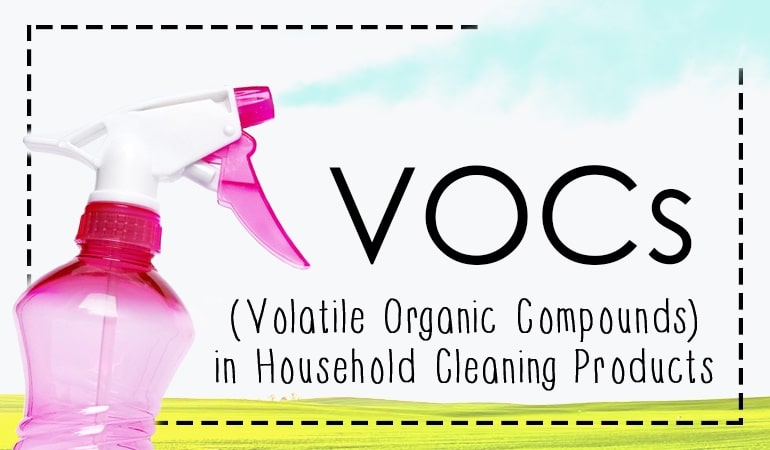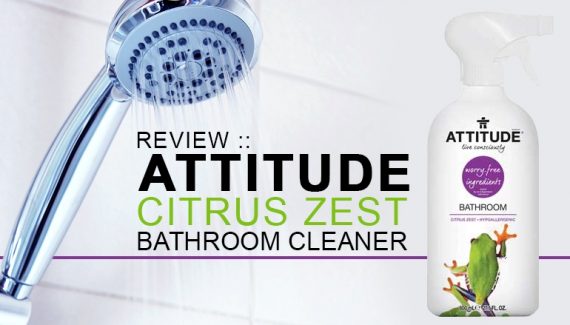Safe Household Cleaning is reader-supported. All reviews are independent and any products reviewed are purchased by the site owner. To help fund this model, some of the links on the site are affiliate links. If you decide to make a purchase from one of these links, this site will receive some commission. At no cost to you. It helps keeps this place running. Learn more
Awareness of VOCs (Volatile Organic Compounds) has increased over the last few years, but there is still so much disinformation and scare stories if you read about them online. Yes, VOCs are real. Yes, they can harm your health. But you can take reasonable measures to reduce or completely remove exposure to the most harmful ones.
The purpose of this article is to look objectively at VOCs in your cleaning products, describe what they are, what risks they present and how you can mitigate these risks.
What’s in this article:
- What are VOCs
- What are the risks of exposure to them
- How do I recognize them on ingredient labels
- How to reduce exposure to them
What are VOCs?
Volatile organic compounds (VOCs) are chemicals that pollute the air around us, released by everyday items, such as: cleaning products (detergents, bleaches), air fresheners, paints, and deodorants. The chemicals easily evaporate at room temperature (are ‘volatile’), and are used in the manufacturing process or specifically added to products as fragrances, aerosols, or preservatives as examples [1].
There are numerous VOCs in everyday household products, although this may not always be clear from the ingredient label. The most common VOCs in our homes, with documented effects on human health, include [2]:
- Glycol ethers (2-butoxyethanol)
- Hydrocarbons (Benzene, Toluene)
- Chlorinates (Carbon Tetrachloride, Tetrachloroethylene)
- Terpenes (Limonene)
- Phthalates (Butylbenzyl Phthalate, Dibutyl Phthalate)
- Isothiazolinones (Methylisothiazolinone (MI), Methylchloroisothiazolinone (MCI), and Benzisothiazolinone (BIT)
- Formaldehyde
- 1,4-dioxane
This list isn’t exhaustive and as we encounter them the list will grow.
It is worth noting that VOCs in household products can react with the air around us to create further VOCs, which can themselves be associated with health risk.
What are the risks of VOCs in cleaning products?
A 2003 California Air Resources Board study found that cleaning products alone account for 7.4tonnes of VOCs released per day (based on a population of 33 million, which equals around 82grams per person every year) [3]. This considerable VOC pollution has been shown, or associated, with a range of adverse health effects.
- Asthma
Asthma attacks can be triggered by a range of allergens and household pollutants, including VOCs. Household exposure to VOCs has been shown increase the risk of asthma, with a 1.6-fold higher risk in adults [4], and 1.5 to 2.5-fold risk in children [5]. In California, it has been reported that 11% of work-related asthma attacks are due to VOCs in cleaning products [6].
It should be noted that a 2015 systematic review of 53 studies evaluating VOCs in asthma concluded that much of the evidence was of low quality, with inconsistent results [7]. Larger clinical trials are required into if and how VOCs increase the risk of asthma, and if a reduction in exposure to VOCs can clinically improve the symptoms of asthma. However, the risk is very real as it stands.
- Eczema, contact dermatitis and skin conditions Much like asthma, household exposure to VOCs has been associated with an increased risk of eczema, with the risk shown to be between 1.1 and 2.3-fold [5]. In addition, the ingredients in cleaning products are thought the be responsible for contact dermatitis in 0.7% of the population [8]. Household exposure to VOCs is thought to increase the risk of experiencing skin reactions to the irritant ingredients in cleaning products [9].
- Endocrine and immune disruption Many VOCs have individually shown to be responsible for endocrine (mostly with effects on fertility) or immune disruption (unexpected inflammatory responses) [10]. These studies have mostly been in animals, and high-quality studies linking household VOC exposure to hormone disruption in humans are lacking. The correlation is often made because these VOCs can be detected in low quantities in human blood, but the effects aren’t yet clear.
- Cancer Several VOCs are known or probable human carcinogens, including formaldehyde and benzene. A 2007 study by researchers at Harvard School of Public Health determined that the overall lifetime risk of cancer due to VOCs was between 0.06-0.1% – although this study included indoor and outdoor exposure, in addition to dietary sources [11]. Permittable levels of the most carcinogenic VOCs in cleaning products are restricted nationally.
Recognizing VOCs on ingredient labels?
Unfortunately, labelling regulations in the EU and US allow product manufacturers to provide very little ingredient information to consumers. In Europe, only ingredients over 0.2% or known to be harmful (excluding those used in the manufacturing process) are required to be on the label. In the US the situation is even worse, and the manufacturer can disclose the ingredients they want to disclose.
This means most VOCs cannot be found on ingredient labels.
This is where we come in. We will only review cleaning products where the manufacturer has provided full disclosure of all ingredients within the product.
We then list the ingredients in our review. Highlight which ones are worth looking out for. And the decision is then yours.
So, the easiest way to avoid VOCs (and other harmful ingredients) is to understand which ingredients you most want to avoid (phthalates, chlorinated bleaches, fragrances, benzene) and look for products that are free of these ingredients.
[Note: Don’t be fooled by natural, hypoallergenic, sensitive skin or green products. They may contain as many VOCs as other products, and so this cannot be used to reliably determine product composition]
Can you reduce exposure to VOCs?
It’s extremely tough to eliminate VOCs exposure, due to their prevalence in household products, and steps can be taken to reduce the risk. Steps to reduce VOC exposure include:
- Open windows and doors to increase ventilation
- Follow product instructions (e.g. standing certain distance away)
- Never mix cleaning products. This may inadvertently create harmful VOCs.
- Understand what ingredient s are in products that you use, and recognize/monitor the most harmful components
- Use less toxic alternatives where available (for example, cleaning with baking soda and vinegar)
Summary
VOCs are potentially harmful pollutants, released by household items, including cleaning products and air fresheners. These have been associated with a range of adverse health effects, including asthma, eczema, reduced fertility, and cancer risk. It can be difficult to find reliable ingredient information for VOCs in cleaning products, and so milder alternatives or ‘ingredient-free’ products are often the only options.
References
- Steinemann, A. Volatile emissions from common consumer products. 2015. Air Quality, Atmosphere & Health. 8(3), 273-281.
- Nazaroff, W. W., & Weschler, C. J. Cleaning products and air fresheners: exposure to primary and secondary air pollutants. 2004. Atmospheric Environment. 38(18), 2841-2865.
- California Air Resources Board (CARB). Consumer and Commercial Products Survey—Summary of Sales and Emissions. 2003. Sacramento, CA.
- Arif, A. A., & Shah, S. M. Association between personal exposure to volatile organic compounds and asthma among US adult population. 2007. International Archives of Occupational and Environmental Health. 80(8), 711-719.
- Choi, H., Schmidbauer, N., Sundell, J., Hasselgren, M., Spengler, J., & Bornehag, C. G. Common household chemicals and the allergy risks in pre-school age children. 2010. Public Library of Science. 5(10), e13423.
- California Department of Public Health. Healthy Cleaning and Asthma-Safer Schools. October 2014. www.cdph.ca.gov
- Nurmatov, U. B., Tagiyeva, N., Semple, S., Devereux, G., & Sheikh, A. Volatile organic compounds and risk of asthma and allergy: a systematic review. 2015. European Respiratory Review. 24(135), 92-101.
- Belsito, D. V., Fransway, A. F., Fowler, J. F., Sherertz, E. F., Maibach, H. I., Mark, J. G., & Nethercott, J. R. Allergic contact dermatitis to detergents: a multicenter study to assess prevalence. 2002. Journal of the American Academy of Dermatology. 46(2), 200-206.
- Huss-Marp, J., Eberlein-Koenig, B., Darsow, U., Breuer, K., Mair, S., Kraemer, U., & Behrendt, H. Short term exposure to volatile organic compounds enhances atopy patch test reaction. 2004. Journal of Allergy and Clinical Immunology. 113(2), S56-S57.
- Kimber, I., & Dearman, R. J. An assessment of the ability of phthalates to influence immune and allergic responses. 2010. Toxicology. 271(3), 73-82.
- Loh, M. M., Levy, J. I., Spengler, J. D., Houseman, E. A., & Bennett, D. H. Ranking cancer risks of organic hazardous air pollutants in the United States. 2007. Environmental Health Perspectives. 115(8),



No Responses Yet